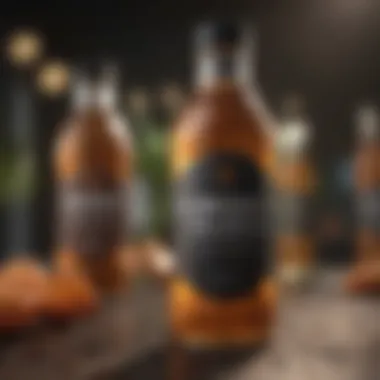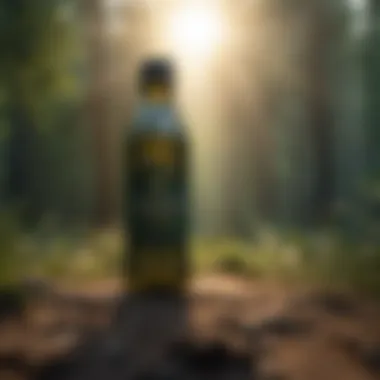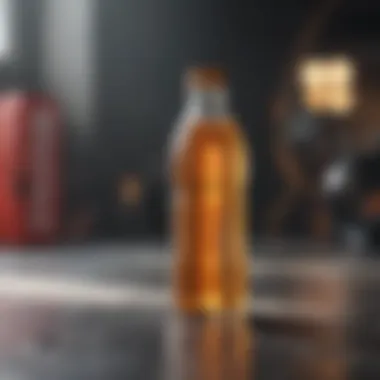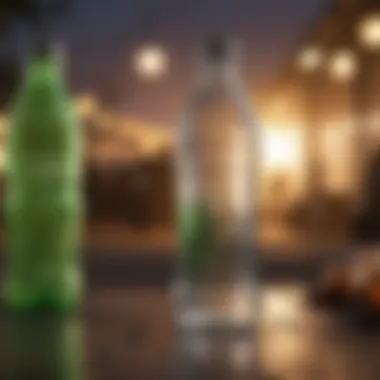Revolutionizing Conservation: The Remarkable Edible Bottle Innovation


Equipment and Gear
When delving into the realm of the innovative edible bottle, it's crucial to understand the equipment and gear required for its production and usage. Unlike traditional plastic containers, these bottles necessitate specialized equipment to ensure their integrity and safety. Manufacturers rely on cutting-edge machinery designed specifically for creating edible bottles. Intricate molds and shaping systems are utilized to craft these unique containers with precision and durability. As sustainability drives the demand for eco-friendly packaging solutions, the equipment used in producing edible bottles undergoes continuous improvement and innovation. From mixing and heating ingredients to molding and shaping the final product, every step in the production process relies on advanced gear and machinery.
Techniques and Training
The development and utilization of edible bottles require a certain level of expertise and training. Professionals in this field need to master specific techniques to ensure the quality and safety of the final product. Training programs focusing on edible packaging materials have emerged to meet the growing demand for sustainable alternatives to traditional plastics. Individuals involved in the production and distribution of edible bottles undergo rigorous training to understand the composition, properties, and handling of these innovative containers. From mastering the art of crafting edible packaging to ensuring compliance with quality standards, specialized training programs play a vital role in promoting the adoption of this eco-friendly solution.
Safety and Risk Management
While edible bottles offer a sustainable alternative to plastic containers, safety and risk management remain paramount in their production and use. Strict protocols are implemented to safeguard against potential hazards and ensure consumer well-being. Professionals involved in creating edible bottles adhere to stringent safety measures to prevent contamination and ensure the integrity of the product. Hazard analysis and risk assessment are conducted regularly to identify and mitigate any potential risks associated with edible packaging. Emergency response plans are in place to address unforeseen circumstances and uphold the safety standards essential for promoting consumer trust and confidence in this innovative solution.
Events and Competitions
In the realm of sustainable packaging solutions, events and competitions serve as platforms for showcasing the latest innovations and driving industry growth. Competitions focusing on sustainable products like edible bottles attract talented individuals and organizations dedicated to promoting environmental conservation. These events provide a stage for manufacturers to highlight their advancements in edible packaging and compete for recognition within the industry. From product demonstrations to panel discussions on sustainability, these gatherings foster collaboration and knowledge exchange among stakeholders committed to advancing eco-friendly packaging solutions.
Lifestyle and Community
The adoption of edible bottles signifies a shift towards a more sustainable lifestyle and a sense of community among environmentally-conscious individuals. Embracing this innovation extends beyond consumer choice; it reflects a shared commitment towards conserving our planet's resources and reducing plastic waste. Communities centered around sustainable practices and eco-friendly initiatives celebrate the introduction of edible bottles as a step towards a greener future. Lifestyle publications and forums dedicated to eco-conscious living promote the use of edible packaging as a part of a holistic approach to sustainable living, emphasizing the importance of individual actions in driving positive environmental change.
Introduction
The necessity of sustainable alternatives in today's environmental landscape cannot be overstated. With the burgeoning concerns surrounding the detrimental impact of plastic pollution on ecosystems, it has become imperative to explore innovative solutions that can mitigate these challenges effectively. The introduction of edible bottles represents a groundbreaking concept that holds the potential to revolutionize the traditional packaging industry. By delving into the composition, production process, and environmental implications of edible bottles, this article aims to shed light on the transformative journey towards promoting sustainability and conservation efforts.
Understanding the Need for Sustainable Alternatives
The Rise of Environmental Concerns
The escalating global anxiety regarding environmental degradation and its cascading effects on ecosystems has prompted a paradigm shift in consumer behavior and industrial practices. The rise of environmental concerns has sparked a critical discourse on the urgent need for sustainable alternatives to traditional plastic packaging. This shift towards more eco-conscious decisions indicates a gradual awakening to the repercussions of past practices and a collective push towards embracing greener solutions.
Impact of Plastic Pollution on Ecosystems
The pervasive impact of plastic pollution on terrestrial and marine ecosystems is undeniable. From contaminating water bodies to endangering wildlife, the far-reaching consequences of plastic waste pose a formidable threat to biodiversity and ecological balance. Understanding the dire implications of plastic pollution serves as a catalyst for exploring and implementing alternatives like edible bottles that offer a promising avenue for reducing environmental harm.
Shift Towards Eco-Friendly Solutions


The current trajectory towards adopting eco-friendly solutions is a testament to society's evolving ethos and commitment to sustainable practices. The paradigmatic shift towards embracing eco-conscious alternatives signifies a departure from conventional norms towards a more environmentally conscious future. This transition underscores the growing recognition of the interdependence between human activities and ecological well-being, fostering a collective responsibility to address environmental challenges proactively.
Introduction to Edible Bottles
Definition and Composition
The concept of edible bottles encapsulates a novel approach to packaging that integrates biodegradable components to create containers that are not only functional but also consumable. The composition of edible bottles typically comprises edible polymers and compounds that align with food-grade standards, ensuring safety and recyclability. This distinctive blend of ingredients underscores the innovative nature of edible packaging, offering a sustainable alternative to conventional plastic containers.
Evolution of Edible Packaging
The evolution of edible packaging signifies a progressive transition towards more environmentally friendly practices within the packaging industry. From initial experimentation to the advancement of production techniques, the journey of edible packaging reflects a commitment to innovation and sustainability. The evolution of edible packaging underscores the adaptability of the industry to meet changing consumer demands while prioritizing environmental responsibility.
Benefits of Edible Bottles
The adoption of edible bottles presents a myriad of benefits that extend beyond traditional packaging solutions. Apart from reducing plastic waste and carbon footprint, edible bottles offer an engaging and interactive consumer experience. The multifaceted advantages of edible bottles encompass environmental conservation, consumer convenience, and resource efficiency, making them a compelling choice in the realm of sustainable packaging solutions.
Scope of the Article
Overview of Key Topics Covered
This article navigates through the intricate tapestry of edible bottles, exploring key facets such as composition, production processes, environmental impact, and consumer perception. By dissecting each element comprehensively, readers will gain a holistic understanding of the significance of edible bottles in fostering sustainability and environmental conservation. The overview of key topics covered sets the stage for a nuanced discussion on the transformative potential of edible bottles in reshaping the future landscape of packaging and environmental stewardship.
Composition of Edible Bottles
In the realm of sustainability and environmental conservation, the composition of edible bottles holds a pivotal position. These bottles are a revolutionary solution that addresses the pressing issue of plastic pollution. By utilizing natural ingredients, edible bottles offer a biodegradable and eco-friendly alternative to traditional plastic containers. The significance of understanding the composition lies in its potential to mitigate the environmental impact of plastic waste while promoting a circular economy. Through the exploration of natural ingredients, production processes, and quality standards, this article aims to unravel the essence of edible bottles in reshaping the future of packaging.
Natural Ingredients Used
Biodegradable Components
The inclusion of biodegradable components is a cornerstone in the creation of edible bottles. These components possess the unique ability to decompose naturally, reducing the accumulation of non-biodegradable waste in landfills and oceans. The key characteristic of biodegradable components lies in their environmentally friendly nature, offering a sustainable packaging solution. However, it is essential to consider the rate of decomposition and the overall impact on ecosystems to ensure the effectiveness of these components in enhancing environmental sustainability.
Edible Polymers and Compounds
Edible polymers and compounds play a vital role in the structural integrity and safety of edible bottles. These materials contribute to the durability and flexibility of the bottles, ensuring they can withstand various environmental conditions. The key characteristic of edible polymers and compounds is their food-grade quality, making them a safe choice for storing consumable liquids. While offering advantages in terms of sustainability and safety, there may be challenges regarding the sourcing and production costs of these specialized materials in the context of edible packaging.


Production Process
Extrusion and Molding Techniques
The production process of edible bottles involves intricate extrusion and molding techniques. Extrusion allows for the creation of unique bottle shapes and sizes, enhancing the aesthetic appeal and functionality of the final product. Molding techniques ensure uniformity and consistency in the texture and thickness of the bottles, contributing to their overall quality. The key characteristic of extrusion and molding lies in their ability to transform raw materials into viable packaging solutions efficiently. Despite their benefits, maintaining strict quality control during extrusion and molding is crucial to avoid defects that could compromise the integrity of the bottles.
Flavoring and Texturing Methods
Flavoring and texturing methods add an innovative dimension to edible bottles, enhancing the sensory experience for consumers. By incorporating natural flavors and textures, manufacturers can cater to diverse preferences and enhance the palatability of the bottled contents. The key characteristic of flavoring and texturing methods is their ability to create distinct product offerings that stand out in the market. While these methods provide a unique selling point for edible bottles, companies must navigate consumer taste preferences and regulatory guidelines to ensure compliance and consumer satisfaction.
Quality and Safety Standards
Regulatory Compliance
Adhering to regulatory compliance standards is imperative in the production of edible bottles. These standards ensure that the bottles meet specific health and safety requirements, guaranteeing consumer protection. The key characteristic of regulatory compliance lies in its role in upholding industry norms and legal obligations, fostering trust between manufacturers, consumers, and regulatory bodies. While compliance adds a layer of assurance regarding product quality, it also entails rigorous testing procedures and documentation to demonstrate adherence to established guidelines.
Food-Grade Certification
Obtaining food-grade certification is a hallmark of quality assurance for edible bottles. This certification signifies that the bottles are safe for storing food and beverages, adhering to strict hygiene and material standards. The key characteristic of food-grade certification is its validation of the bottles' suitability for direct contact with consumable items. While certification enhances the credibility of manufacturers and instills confidence in consumers, acquiring and maintaining certification involves continuous monitoring and compliance with evolving food safety regulations.
Environmental Impact and Sustainability
As we delve into the realm of environmental impact and sustainability within the context of the groundbreaking innovative edible bottle, it becomes imperative to underline the crucial role that this topic plays in shaping the future of eco-friendly solutions. The overarching goal of mitigating plastic waste and preserving our ecosystems resonates profoundly in the development and adoption of edible bottles. By opting for sustainable alternatives like edible bottles, we actively contribute to reducing the environmental footprint associated with traditional plastic containers. The integration of these eco-conscious practices into our daily lives stands as a beacon of hope for a more sustainable and greener future.
Reduction of Plastic Waste
In elaborating on mitigating the environmental footprint through edible bottles, it's essential to acknowledge the significant strides made towards reducing plastic waste. The innovative aspect of edible bottles lies in their intrinsic ability to minimize the negative impact on the environment. Through a holistic approach to sustainable packaging, edible bottles facilitate the reduction of plastic waste by providing a viable alternative. Their biodegradable nature ensures that once consumed, they do not linger in landfills, thus aiding in preserving our ecological balance.
Promoting Circular Economy
Within the framework of promoting a circular economy, edible bottles offer a unique value proposition. By embracing the concept of circularity, where resources are utilized efficiently, recycled, and repurposed, these bottles embody the essence of environmental stewardship. Promoting a circular economy through the adoption of edible bottles fosters a symbiotic relationship between consumption and conservation. This circular model not only minimizes waste but also fuels a sustainable production cycle, paving the way for a more regenerative and resource-efficient economy.
Resource Conservation
The utilization of renewable resources encapsulates the essence of resource conservation within the realm of edible bottles. By harnessing the power of naturally replenishable materials, such as biodegradable components and edible polymers, these bottles exemplify sustainable innovation. The emphasis on renewable resources not only reduces dependency on finite materials but also showcases a commitment to preserving our natural ecosystems for future generations.


Consumer Perception and Adoption
When dissecting consumer perception and adoption of edible bottles, it's crucial to shine a light on the pivotal role that educating consumers plays in driving sustainable choices. By fostering awareness about the benefits of edible packaging and advocating for eco-friendly alternatives, consumers can make informed decisions that align with environmental conservation goals. Educating consumers about the positive impact of edible bottles empowers them to actively participate in the sustainability movement, catalyzing a shift towards greener consumption practices.
Increasing Acceptance and Demand
In tandem with educating consumers, fostering increasing acceptance and demand for edible bottles is instrumental in amplifying their environmental impact. By cultivating a culture of acceptance and preference for sustainable packaging solutions, the demand for edible bottles surges, creating a ripple effect across industries. The intrinsic benefits of edible bottles, such as biodegradability and eco-friendliness, serve as key drivers in enhancing their acceptance and demand in the market, propelling the momentum towards a more sustainable future.
Future Prospects and Innovations
In this article, the section on Future Prospects and Innovations delves into the significant advancements and potential developments surrounding edible bottles. This segment is crucial as it provides a glimpse into the trajectory of this sustainable solution in environmental conservation efforts. By examining the research and development initiatives within the realm of edible packaging, it sheds light on the innovation and creativity driving the adoption of such alternatives.
Research and Development Initiatives
Advancements in Edible Packaging Technology
The advancements in edible packaging technology represent a cornerstone in the progression of eco-friendly packaging solutions. These innovations aim to enhance the functionality and sustainability of edible bottles, making them more viable for widespread adoption. A key characteristic of these advancements lies in their ability to maintain the structural integrity of the bottles while ensuring they are safe for consumption. This trait ensures that consumers can trust the durability and safety of these containers, thus contributing significantly to the overarching goal of reducing plastic waste.
Enhancing Durability and Shelf Life
Enhancing the durability and shelf life of edible bottles addresses a crucial aspect of their practicality and viability in the market. By improving the longevity of these containers, manufacturers can enhance their usability and appeal to consumers. The key characteristic of this enhancement lies in finding the balance between maintaining the product's integrity and extending its shelf life without compromising on environmental sustainability. This balance ensures that edible bottles remain a reliable and sustainable alternative to traditional plastic containers, thus driving their widespread adoption.
Collaborations and Partnerships
Industry Engagement for Scaling Production
Industry engagement for scaling production plays a pivotal role in expanding the reach and impact of edible bottles in the market. By collaborating with various industries involved in production and distribution, stakeholders can streamline processes and optimize efficiency. The key characteristic of such collaborations is the collective effort to increase production capacity while adhering to quality and safety standards. This approach not only accelerates the availability of edible bottles but also ensures consistent quality and adherence to regulatory requirements.
Cross-Sector Collaboration for Innovation
Cross-sector collaboration for innovation represents a strategic approach to fostering out-of-the-box solutions and continuous improvement in edible packaging. By pooling resources and expertise from different sectors, stakeholders can leverage diverse perspectives to drive innovation. The key characteristic of such collaborations is the infusion of fresh ideas and practices from unrelated industries, leading to novel approaches and breakthroughs in edible packaging technology. This cross-pollination of ideas fuels the advancement of sustainable packaging solutions and enhances the overall competitiveness of edible bottles in the market.
Global Adoption and Market Trends
Integration in Consumer Products
The integration of edible bottles in consumer products marks a significant shift towards sustainability in everyday consumption. By incorporating these innovative containers into various product lines, manufacturers can offer eco-conscious alternatives to consumers. The key characteristic of this integration is the seamless incorporation of edible bottles into existing product packaging, ensuring a smooth transition for consumers. This integration not only promotes sustainability but also reflects the evolving consumer preferences towards environmentally friendly options.
Market Growth and Forecast
The market growth and forecast for edible bottles underscore their rising prominence and market viability. As consumer awareness of environmental issues increases, the demand for sustainable packaging solutions like edible bottles is projected to surge. The key characteristic of this forecast is the exponential growth potential within the eco-friendly packaging sector, driven by shifting consumer preferences and regulatory initiatives. This forecast indicates a promising future for edible bottles, positioning them as key players in the movement towards a more sustainable and environmentally conscious market.













